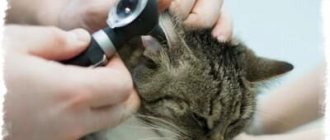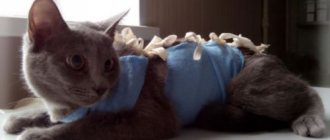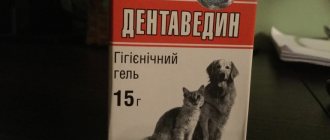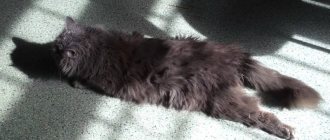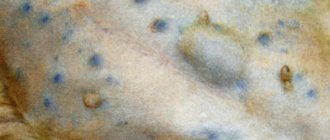Causes of glomerulonephritis Symptoms of glomerulonephritis in cats Diagnosis Treatment Glomerulonephritis in cats is an immune disease, inflammation of the glomeruli, the glomeruli of the kidneys responsible for filtration.
Glomerulonephritis appears as a result of the entry of an immune complex (an immune complex is antibodies associated with antigens) into the renal glomeruli, causing their inflammation, swelling and the formation of scar tissue in place of the functional one. This causes a marked deterioration in the filtering ability of the kidneys and causes blood and proteins to enter the urine.
Description
Glomerulonephritis is a kidney disease in which the glomerular apparatus of an animal becomes inflamed.
Does not belong to the group of infectious diseases of the genitourinary organs. Inflammation develops due to bacteria entering the basement membranes. Harmful substances affect the animal’s immunity, damaging the structure of the glomeruli. Hypothermia can contribute to the rapid development of microorganisms that affect the organs of the genitourinary system. At low temperatures, bacteria multiply rapidly, causing damage to lysosomes. They are responsible for blood clotting. Due to impaired circulation of the blood flow, inflammation of the genitourinary organs occurs, accompanied by a decrease in immunity.
Pathogenesis
The immunological mechanisms of damage to the glomeruli are associated with the formation of specific antibodies that interact with antigens (exogenous - drugs, foreign proteins of microbes, viruses and protozoa) or (endogenous - DNA, antigen of the nuclei and ribosomes of cells, elements of the glomerular basement membrane), with the formation of immune complexes antigen - antibody. Immune complexes, circulating in the blood, are excreted through the glomerular filter and getting stuck in it, causing damage to the kidney tissue.
Causes
The disease has three forms: acute, subacute and chronic. Glomerulonephritis is detected in cats of different ages, regardless of breed. The disease is often detected in animals between 3 and 5 years of age.
The acute and subacute forms are caused by different irritants. The disease occurs due to infection in the animal's body: Pseudomonas aeruginosa, viruses, leptospirosis and hepatitis. Due to the ingress of harmful substances, sodium is retained in the genitourinary system. It disrupts kidney filtration, which leads to edema. Together, the functioning of the cardiovascular system is disrupted in cats.
Causes of the disease:
- cancer;
- diabetes;
- feline immunodeficiency virus;
- long-term exposure to chemicals and drugs on the body;
- hypothermia of the animal;
- abdominal injuries;
- long-term physical activity;
- being in damp areas;
- taking antibiotics, vaccines or serums;
- decreased immunity.
The causes of glomerulonephritis are diseases: pancreatitis, endocarditis, pyometra. Owners of animals prone to such diseases need to periodically visit a veterinarian and get tested to detect kidney failure.
The cause is often prolonged consumption of dry food. Kidneys need vitamins that are found in vegetables and meat.
Feeding cats with kidney disease
For all kidney diseases, a therapeutic diet is prescribed. Properly selected food can prolong a cat’s life and improve its quality. Only a doctor prescribes a diet for sick animals - experiments in such a serious matter can lead to a sad outcome.
Veterinarians usually recommend switching the animal to ready-made medicated food. It is difficult to create a menu from natural products that will meet the needs of a sick cat.
Recommended brands of food:
- Eukanuba Renal;
- Clan Vet RENAL;
- Hill's Prescription Diet K/D Feline Renal Health;
- Brid VDC Renal;
- Farmina Vet Life Renal;
- Royal Canin Renal RF23;
- Pro Plan Veterinary Diets Feline UR Urinary;
- Monge Grain Free Vetsolution Renal Feline;
- Purina Veterinary Diets N;
- Sanabelle Urinary.
Symptoms
Often glomerulonephritis is asymptomatic, periodically showing its presence with pain in the kidney area. An accurate diagnosis is made only on the basis of diagnostics and testing.
Symptoms of glomerulonephritis are varied. They depend on the age of the animal, general health, and form of the disease. Symptoms are more pronounced in the acute form. Cats get very tired, become inactive, and eat little. In the chronic form, which lasts for years, the organs of the cardiovascular and nervous systems are affected.
The appearance of a red, dense liquid in the urine indicates the presence of the disease. Because of this, the discharge becomes brown, dark in color and has an unpleasant odor.
Symptoms of the disease also include:
- decreased appetite;
- excessive fluid intake;
- hair loss;
- deterioration of vision, hearing;
- frequent trips to the toilet;
- indigestion (vomiting);
- increased blood pressure;
- deterioration of general condition, pallor;
- the appearance of edema.
The owner should take their cat to the veterinarian and get diagnosed if the animal has an increased belly size. With glomerulonephritis, it increases in volume, causing pain.
What kind of disease is this?
You should start with a short course in anatomy and physiology. So what are kidneys? These are organs that got their name due to their external similarity to tree buds, and perform the most important excretory function. They synthesize urine, with which nitrogenous bases, bilirubin, toxins and other metabolic products are released into the external environment.
The bulk of this work lies with the glomeruli. These are the morphofunctional units of the organ. They are a kind of molecular filters. In the process of their work, two types of urine are formed: primary, similar in composition to blood plasma, and secondary, directly released into the external environment during the act of urination. There are millions of glomeruli in the kidneys. When these structures are damaged, kidney function is significantly impaired, and toxins in the blood rapidly increase, causing many severe effects.
Attention! Glomerulonephritis is precisely the name given to inflammation of the glomeruli. In cats, a common cause of this disease is autoimmune pathologies, in which the kidneys are attacked by the body's defense system.
Laboratory diagnostic methods
Once symptoms are detected, the owner will have to take the animal to a veterinary clinic. Diagnosis begins with a physical examination. The doctor examines the cat's belly, then the front legs and head for swelling.
To confirm the diagnosis, the body is examined:
- Taking a urine test to show the presence of bacteria in the discharge.
- Taking blood to determine diseases of the cardiovascular system.
- Donating blood for clotting.
- X-ray of the abdominal cavity.
- Kidney bioscopy and control ultrasound examination.
The latter diagnosis has contraindications. It is prohibited for animals that are missing one of the kidneys, have poor blood clotting, or have a cyst.
Diagnosis
To accurately diagnose glomerulonephritis, a kidney biopsy is necessary. In most cases, a urine test is sufficient to make only a preliminary, presumptive diagnosis. In this case, a sharply increased level of protein in the urine (proteinuria) is detected. Often the urine will also contain hyaline casts, which are ideal "imprints" of the renal tubules. Their detection indicates severe kidney pathologies (not only glomerulonephritis).
Urine culture is useful in identifying bladder infection as a cause of proteinuria. In addition, it is necessary to analyze the ratio of plasma protein and creatine. If it is disrupted, then there is 100% something very wrong with the kidneys.
Treatment
Treatment of glomerulonephritis is prescribed by the attending physician. Depending on the degree of the disease, form, and age of the animal, diet and medications are prescribed.
First aid
After detecting symptoms of glomerulonephritis, you need to quickly take the cat to the veterinarian. You cannot try to cure the disease on your own, since it has 3 main forms, and individual treatment is selected for each. The attending physician prescribes antibiotics and other drugs. Giving a cat painkillers increases the chance of a misdiagnosis after diagnosis.
Basic treatment
Based on the diagnostic results, the veterinarian prepares a comprehensive diet for the cat. The main task of the owner is to provide the animal with medicines and comfortable living conditions. Hypothermia, stress, and contact with other cats should not be allowed.
During the first 2 days of the diet, the animal is prohibited from giving food. After this, you are allowed to take porridge, vegetables and other easily digestible foods. Food should contain calcium and carbohydrates, which are necessary to obtain energy and maintain immunity.
It is also recommended to consume foods containing:
- retinol;
- vitamins A, B;
- ascorbic acid;
- tocopherol
The main treatment is aimed at eliminating the symptoms of glomerulonephritis. Blood circulation improves, which affects the proper functioning of the genitourinary system. Antibiotics are used to treat the acute form of the disease caused by an infection. They affect the cat's gastrointestinal tract and liver. To make it easier to take the medicine, gentle medications are prescribed: Kefzol, Fotum. To maintain the functioning of the stomach, palin and syrups are used together, restoring the internal intestinal microflora.
In case of severe intoxication, use:
- bloodletting;
- 10-100 ml of glucose solution at 20% content, which is administered subcutaneously;
- magnesium sulfate 0.11 mm intramuscularly.
Magnesium sulfate removes excess salt from the body. It also normalizes blood pressure and dilates blood vessels. It is used according to a doctor's prescription. If possible, it is better to have the injections administered by medical professionals.
Together with medications, mineral complexes, vitamins, and food additives are prescribed to strengthen the immune system and reduce fatty acids. To eliminate edema, diuretics are used.
Publications in the media
Chronic glomerulonephritis (CGN, slowly progressive glomerular disease, chronic nephritic syndrome) is a group concept that includes diseases of the glomeruli of the kidney with a common immune mechanism of damage and a gradual deterioration of renal function with the development of renal failure.
CLASSIFICATION
Clinical (Tareev E.M., Tareeva I.E., 1958, 1972) • By form •• Latent form •• Hematuric form (see Berger’s disease) •• Hypertensive form •• Nephrotic form •• Mixed form • By phases •• Exacerbation (active phase) - increasing changes in urine (proteinuria and/or hematuria), the appearance of acute nephritic or nephrotic syndrome, decreased renal function •• Remission - improvement or normalization of extrarenal manifestations (edema, arterial hypertension), renal function and changes in urine.
Morphological (Serov V.V. et al., 1978, 1983) includes eight forms of CGN • Diffuse proliferative glomerulonephritis (see Acute glomerulonephritis) • Glomerulonephritis with crescents (see Rapidly progressive glomerulonephritis) • Mesangioproliferative glomerulonephritis • Membranous glomerulonephritis • Membrano-pro proliferative ( mesangiocapillary) glomerulonephritis • Focal segmental glomerulosclerosis • Fibroplastic glomerulonephritis.
Statistical data. Incidence is 13–50 cases per 10,000 population. Primary CGN occurs 2 times more often in men than in women, secondary - depending on the underlying disease. It can develop at any age, but is most common in children 3–7 years old and adults 20–40 years old.
Etiology
• The same etiological factor can cause different morphological and clinical variants of nephropathies and, conversely, different causes can cause the same morphological variant of damage.
• Diffuse proliferative - see Acute glomerulonephritis.
• Glomerulonephritis with crescents (see Rapidly progressive glomerulonephritis).
• Mesangioproliferative glomerulonephritis - hemorrhagic vasculitis, chronic viral hepatitis B, Crohn's disease, Sjögren's syndrome, ankylosing spondylitis, adenocarcinomas.
• Membranous glomerulonephritis - carcinomas of the lung, intestines, stomach, mammary glands and kidneys (paraneoplastic glomerulonephritis), non-Hodgken lymphoma, leukemia, SLE (see Lupus nephritis), viral hepatitis B, syphilis, filariasis, malaria, schistosomiasis, exposure to drugs (gold preparations and mercury, as well as trimethadione and penicillamine).
• Membrane-proliferative glomerulonephritis - idiopathic, as well as secondary to SLE, cryoglobulinemia, chronic viral (HCV) or bacterial infections, drugs, toxins.
• CGN with minimal changes - idiopathic, as well as acute respiratory infections, vaccinations, NSAIDs, rifampicin or a-IFN, Fabry disease, diabetes, lymphoproliferative pathology (Hodgken lymphoma).
• Focal segmental glomerulosclerosis - idiopathic, as well as sickle cell anemia, kidney transplant rejection, cyclosporine, surgical excision of part of the renal parenchyma, chronic vesicoureteral reflux, heroin use, congenital pathology (nephron dysgenesis, late stages of Fabry disease), HIV infection.
Pathogenesis
• Immune mechanisms are involved in the development and maintenance of inflammation •• Immunocomplex •• Antibody (autoantigenic) •• Activation of complement, attraction of circulating monocytes, synthesis of cytokines, release of proteolytic enzymes and oxygen radicals, activation of the coagulation cascade, production of pro-inflammatory PGs.
• In addition to immune and non-immune mechanisms, the progression of CGN involves •• Intraglomerular hypertension and hyperfiltration •• Proteinuria (nephrotoxic effects of proteinuria have been proven) •• Hyperlipidemia •• Excessive formation of oxygen free radicals and accumulation of lipid peroxidation products •• Excessive calcium deposition •• Intercurrent recurrent urinary tract infections.
Pathomorphology depends on the morphological form of CGN. In any form, signs of sclerosis of varying degrees are revealed in the glomeruli and interstitium - synechiae, sclerotic glomeruli, tubular atrophy. Proliferation and activation of mesangial cells play a key role in the processes of accumulation and changes in the structure of the extracellular matrix, which ends in sclerosis of the glomerulus. Pathomorphological changes are of exceptional importance for the diagnosis of glomerulonephritis, because Diagnosis almost always requires a biopsy of the kidney tissue.
• Diffuse proliferative - diffuse increase in the number of glomerular cells due to infiltration by neutrophils and monocytes and proliferation of glomerular endothelium and mesangial cells.
• Glomerulonephritis with crescents (rapidly progressive) - see Glomerulonephritis, rapidly progressive.
• Mesangioproliferative - proliferation of mesangial cells and matrix.
• Membrane-proliferative - diffuse proliferation of mesangial cells and infiltration of glomeruli by macrophages; increase in mesangial matrix, thickening and doubling of the basement membrane.
• CGN with minimal changes - light microscopy without pathology, with electron microscopy - disappearance of podocyte feet.
• Focal segmental glomerulosclerosis - segmental collapse of capillaries in less than 50% of glomeruli with deposition of amorphous hyaline material.
• Membranous - diffuse thickening of the glomerular basement membrane with the formation of subepithelial projections surrounding immune complex deposits (a jagged appearance of the basement membrane).
• Fibroplastic glomerulonephritis is the outcome of most glomerulopathies and is characterized by the severity of fibrotic processes.
Clinical manifestations • Symptoms appear 3-7 days after exposure to the provoking factor (latent period), they can also be detected accidentally during a medical examination • Recurrent episodes of hematuria • Edema, urinary syndrome, arterial hypertension in various variants - nephrotic or acute nephritic syndrome (nephrotic form, mixed form - up to 10%, hypertensive form - 20–30%) • Possible combination of manifestations of acute nephritic and nephrotic syndromes • Complaints of headache, darkening of urine, swelling and decreased diuresis • Objectively - pastiness or swelling, increased blood pressure, expansion of boundaries heart to the left • Body temperature is normal or subfebrile.
Clinical manifestations in various clinical forms
• Latent CGN (50–60%) •• No edema or arterial hypertension •• In urine proteinuria no more than 1-3 g/day, microhematuria, leukocyturia, casts (hyaline and erythrocyte) •• Can transform into nephrotic or hypertensive forms • • The development of chronic renal failure occurs over 10–20 years.
• Hypertensive chronic hepatitis •• Clinical manifestations of arterial hypertension syndrome •• There is slight proteinuria in the urine, sometimes microhematuria, cylindruria •• Chronic renal failure develops over 15–25 years.
• Hematuric CGN •• In the urine - recurrent or persistent hematuria and minimal proteinuria (less than 1 g/day) •• There are no extrarenal symptoms •• CGN develops in 20–40% over 5–25 years.
• Nephrotic form - clinical and laboratory manifestations of nephrotic syndrome.
• Mixed form •• Combination of nephrotic syndrome, arterial hypertension and/or hematuria •• It is usually noted with secondary CGN, systemic diseases (SLE, systemic vasculitis) •• CRF develops within 2–3 years.
Clinical picture depending on the morphological form
• Mesangioproliferative CGN •• Isolated urinary syndrome •• Acute nephritic or nephrotic syndrome •• Macro- or microhematuria - Berger's disease •• CKD develops slowly.
• Membranous CGN manifests itself as nephrotic syndrome (80%).
• Membrane-proliferative CGN •• Begins with acute nephritic syndrome, in 50% of patients - nephrotic syndrome •• Isolated urinary syndrome with hematuria •• Arterial hypertension, hypocomplementemia, anemia, cryoglobulinemia are characteristic •• The course is progressive, sometimes rapidly progressive.
• Glomerulonephritis with minimal changes •• Nephrotic syndrome, in 20-30% of cases with microhematuria •• Arterial hypertension and renal failure occur rarely.
• Focal segmental glomerulosclerosis •• Nephrotic syndrome •• Erythrocyturia, leukocyturia in the urine •• Arterial hypertension •• Chronic renal failure is a natural development.
• Fibroplastic glomerulonephritis •• Nephrotic syndrome (up to 50%) •• Chronic renal failure •• Arterial hypertension.
Laboratory data
• In the blood - a moderate increase in ESR (with secondary CGN, a significant increase can be detected, which depends on the primary disease), an increase in the level of CEC, antistreptolysin O, a decrease in the content of complement in the blood (immune complex CGN), with Berger's disease an increase in the IgA content is detected.
• Reduced concentrations of total protein and albumin (significantly in nephrotic syndrome), increased concentrations of a2- and b-globulins, hypogammaglobulinemia in nephrotic syndrome. In secondary CGN caused by systemic connective tissue diseases (lupus nephritis), g-globulins may be increased. Hyper- and dyslipidemia (nephrotic form).
• Decreased GFR, increased levels of urea and creatinine, anemia, metabolic acidosis, hyperphosphatemia, etc. (AKI due to chronic renal failure or chronic renal failure).
• In the urine there is erythrocyturia, proteinuria (massive in nephrotic syndrome), leukocyturia, casts are granular, waxy (in nephrotic syndrome).
Instrumental data • With ultrasound or survey urography, the size of the kidneys is normal or reduced (with chronic renal failure), the contours are smooth, the echogenicity is diffusely increased • X-ray of the chest organs - expansion of the borders of the heart to the left (with arterial hypertension) • ECG - signs of left ventricular hypertrophy • Kidney biopsy ( light, electron microscopy, immunofluorescence study) allows you to clarify the morphological form, activity of CGN, and exclude kidney diseases with similar symptoms.
Diagnostics . If diuresis decreases, dark urine appears, edema or pastiness of the face, or blood pressure increases (may be normal), a set of studies is carried out: measurement of blood pressure, total blood flow, total blood volume, determination of daily proteinuria, total protein concentration and evaluate the proteinogram, lipid content in the blood. An in-depth physical and clinical laboratory examination is aimed at identifying the possible cause of CGN - a general or systemic disease. Ultrasound (x-ray) of the kidneys allows you to clarify the size and density of the kidneys. Assessment of kidney function - Reberg-Tareev test, determination of the concentration of urea and/or creatinine in the blood. The diagnosis is confirmed by a kidney biopsy.
Differential diagnosis: with chronic pyelonephritis, acute glomerulonephritis, nephropathy of pregnancy, chronic tubulo-interstitial nephritis, alcoholic kidney damage, amyloidosis and diabetic nephropathy, as well as kidney damage in diffuse connective tissue diseases (primarily SLE) and systemic vasculitis.
TREATMENT
General tactics • Hospitalization in case of exacerbation of CGN, newly diagnosed CGN, newly diagnosed chronic renal failure • Diet with restriction of table salt (for edema, arterial hypertension), protein (for chronic renal failure, exacerbation of CGN) • Impact on the etiological factor (infection, tumors, drugs ) • Immunosuppressive therapy - GCs and cytostatics - for exacerbation of CGN (indicated also for azotemia, if it is caused by the activity of CGN) • Antihypertensive drugs • Antiplatelet agents, anticoagulants • Antihyperlipidemic drugs • Diuretics.
Immunosuppressive therapy
• GCs are indicated for mesangioproliferative CGN and CGN with minimal glomerular changes. With membranous CGN, the effect is unclear. For membrane-proliferative CGN and focal segmental glomerulosclerosis, GCs are ineffective • Prednisolone is prescribed at 1 mg/kg/day orally for 6–8 weeks, followed by a rapid decrease to 30 mg/day (5 mg/week), and then slowly (2.5–1.25 mg/week) until complete withdrawal •• Pulse therapy with prednisolone is carried out with high CGN activity in the first days of treatment - 1000 mg IV drip 1 r/day for 3 days in a row. After CGN activity decreases, monthly pulse therapy is possible until remission is achieved.
• Cytostatics (cyclophosphamide 2-3 mg/kg/day orally or intramuscularly or intravenously, chlorambucil 0.1–0.2 mg/kg/day orally, as alternative drugs: cyclosporine - 2.5 –3.5 mg/kg/day orally, azathioprine 1.5–3 mg/kg/day orally) are indicated for active forms of CGN with a high risk of progression of renal failure, as well as in the presence of contraindications for the use of GCs, ineffectiveness or complications. when using the latter (in the latter case, combined use is preferred, allowing to reduce the dose of GC). Pulse therapy with cyclophosphamide is indicated for high CGN activity, either in combination with pulse therapy with prednisolone (or against the background of daily oral prednisolone), or alone without additional prescription of prednisolone; in the latter case, the dose of cyclophosphamide should be 15 mg/kg (or 0.6–0.75 g/m2 body surface area) IV monthly.
• The simultaneous use of GC and cytostatics is considered more effective than GC monotherapy. It is generally accepted to prescribe immunosuppressive drugs in combination with antiplatelet agents, anticoagulants - the so-called multicomponent regimens: •• 3-component regimen (without cytostatics) ••• Prednisolone 1–1.5 mg/kg/day orally for 4–6 weeks, then 1 mg/day kg/day every other day, then reduced by 1.25–2.5 mg/week until discontinuation ••• Heparin 5000 IU 4 times a day for 1–2 months with a transition to phenindione or acetylsalicylic acid at a dose of 0.25 –0.125 g/day, or sulodexide at a dose of 250 IU 2 times/day orally ••• Dipyridamole 400 mg/day orally or intravenously •• 4-component Kinkaid-Smith regimen ••• Prednisolone 25–30 mg/day daily orally for 1–2 months, then reduce the dose by 1.25–2.5 mg/week until discontinuation ••• Cyclophosphamide 200 mg IV daily or double dose every other day for 1–2 months, then half dose until remission decreases (cyclophosphamide can be replaced with chlorambucil or azathioprine) ••• Heparin 5000 units 4 times a day for 1–2 months with a transition to phenindione or acetylsalicylic acid, or sulodexide ••• Dipyridamole 400 mg/day orally or IV •• Ponticelli regimen: initiation of therapy with prednisolone - 3 consecutive days at 1000 mg/day, the next 27 days prednisolone 30 mg/day orally, 2nd month - chlorambucil 0.2 mg/kg •• Steinberg regimen • •• Pulse therapy with cyclophosphamide: 1000 mg IV monthly for a year ••• In the next 2 years - once every 3 months ••• In the next 2 years - once every 6 months.
Symptomatic therapy
• Antihypertensive therapy •• ACE inhibitors have an antiproteinuric and nephroprotective effect, because, by reducing intraglomerular hyperfiltration and hypertension, they slow down the rate of progression of chronic renal failure: captopril 50–100 mg/day, enalapril 10–20 mg/day, ramipril 2 .5–10 mg/day •• Non-hydropyridine calcium channel blockers: verapamil at a dose of 120–320 mg/day, diltiazem at a dose of 160–360 mg/day, isradipine, etc.
• Diuretics - hydrochlorothiazide, furosemide, spironolactone.
•Antioxidant therapy (vitamin E), but there is no convincing evidence of its effectiveness.
• Lipid-lowering drugs (nephrotic syndrome): simvastatin, lovastatin, fluvastatin, atorvastatin at a dose of 10–60 mg/day for 4–6 weeks, followed by a dose reduction.
• Anticoagulants (in combination with GC and cytostatics, see above) • Heparin 5000 IU 4 times a day subcutaneously (under the control of the international normalized ratio [INR]) for at least 1–2 months; before discontinuation, the dose is reduced 2–3 days before •• Low molecular weight heparins: calcium nadroparin in a dose of 0.3–0.6 ml 1–2 times/day subcutaneously, sulodexide IM 600 IU 1 time/day for 20 days, then orally 250 IU 2 times a day.
• Antiplatelet agents (in combination with GCs, cytostatics, anticoagulants; see above) •• Dipyridamole 400–600 mg/day •• Pentoxifylline 0.2–0.3 g/day •• Ticlopidine 0.25 g 2 r /day •• Acetylsalicylic acid 0.25–0.5 g/day.
The following therapeutic measures are also used in the treatment of CGN (the effect of which has not been proven in controlled studies).
• NSAIDs (an alternative to prednisolone for low clinical activity of CGN): indomethacin 150 mg/day for 4–6 weeks, then 50 mg/day for 3–4 months (contraindicated in arterial hypertension and renal failure).
• Aminoquinoline derivatives (chloroquine, hydroxychloroquine) are prescribed in the absence of indications for active therapy for sclerosing forms, 0.25–0.2 g orally 2 times a day for 2 weeks, then 1 time a day.
• Plasmapheresis in combination with pulse therapy with prednisone and/or cyclophosphamide is indicated for highly active CGN and there is no effect from treatment with these drugs.
Treatment of individual morphological forms
• Mesangioproliferative CGN •• With slowly progressive forms, incl. with IgA nephritis, there is no need for immunosuppressive therapy •• With a high risk of progression - GCs and/or cytostatics •• 3- and 4-component regimens •• The effect of immunosuppressive therapy on long-term prognosis remains unclear.
• Membranous CGN •• Combined use of GCs and cytostatics •• Pulse therapy with cyclophosphamide 1000 mg IV monthly •• In patients without nephrotic syndrome and normal renal function - ACE inhibitors.
• Membrano-proliferative (mesangiocapillary) CGN •• Treatment of the underlying disease •• ACE inhibitors •• In the presence of nephrotic syndrome and decreased renal function, therapy with GC and cyclophosphamide with the addition of antiplatelet agents and anticoagulants is justified.
• CGN with minimal changes •• Prednisolone 1–1.5 mg/kg for 4 weeks, then 1 mg/kg every other day for another 4 weeks •• Cyclophosphamide or chlorambucil if prednisolone is ineffective or cannot be discontinued due to relapses •• For ongoing relapses of nephrotic syndrome - cyclosporine 3-5 mg/kg/day (children 6 mg/m2) 6-12 months after achieving remission.
• Focal segmental glomerulosclerosis •• Immunosuppressive therapy is not effective enough •• GC is prescribed for a long time - up to 16–24 weeks •• Patients with nephrotic syndrome are prescribed prednisolone 1–1.2 mg/kg daily for 3–4 months, then every other day for another 2 months month, then the dose is reduced until discontinuation •• Cytostatics (cyclophosphamide, cyclosporine) in combination with GC.
• Fibroplastic CGN •• With a focal process, treatment is carried out according to the morphological form that led to its development •• Diffuse form is a contraindication to active immunosuppressive therapy.
Treatment according to clinical forms is carried out if it is impossible to perform a kidney biopsy.
• Latent form •• Active immunosuppressive therapy is not indicated. For proteinuria >1.5 g/day, ACE inhibitors are prescribed.
• Hematuric form •• Inconsistent effect of prednisolone and cytostatics •• Patients with isolated hematuria and/or slight proteinuria - ACE inhibitors and dipyridamole.
• Hypertensive form •• ACE inhibitors; target blood pressure level is 120–125/80 mmHg •• For exacerbations, cytostatics are used as part of a 3-component regimen •• GC (prednisolone 0.5 mg/kg/day) can be prescribed as monotherapy or as part of combined regimens.
• Nephrotic form is an indication for a 3- or 4-component regimen.
• Mixed form - 3- or 4-component treatment regimen.
Surgical treatment • Kidney transplantation is complicated in 50% by relapse in the graft, in 10% by graft rejection.
Features of the course in children • More often than in adults, post-streptococcal nephritis with an outcome in recovery • Nephrotic syndrome up to 80% is caused by CGN with minimal changes.
Features of the course in pregnant women • The effect of pregnancy on the kidneys: function decreases, the frequency of secondary gestosis increases • The effect of CGN on pregnancy - three degrees of risk (Shekhtman M.M. et al., 1989): •• I degree (minimal) - pregnancy is possible allow (latent form) •• II degree (severe) - high risk (nephrotic form) •• III degree (maximum) - pregnancy is contraindicated (hypertensive and mixed forms, active CGN, chronic renal failure).
Complications • Renal failure, left ventricular failure, acute cerebrovascular accident, intercurrent infections, thrombosis.
Course and prognosis. The frequency of progression to chronic renal failure depends on the morphological form of CGN • Diffuse proliferative - 1-2% • Mesangioproliferative - 40% • Rapidly progressive - 90% • Membranous - 40% • Focal and segmental glomerulosclerosis - 50-80% • Membranous-proliferative - 50% • IgA nephropathy - 30–50%.
Reduction. CGN - chronic glomerulonephritis.
ICD-10 • N03 Chronic nephritic syndrome
Prevention
Preventive measures to prevent glomerulonephritis include providing care and proper nutrition to the animal. Avoid drafts, hypothermia, and eating fatty, salty, and smoked foods. Feeding dry food causes disease, so it is best to throw it away.
Prevention is divided into 4 groups:
- Monitoring your cat's blood pressure and weight. An increase in weight indicates a disruption in the functioning of the body.
- Visit your doctor once every six months. The appointment is accompanied by tests to identify hidden symptoms.
- Drawing up a nutrition plan. Proper food is rich in vitamins that prevent the occurrence of glomerulonephritis.
- Taking medicinal nutritional supplements.
If a cat is predisposed to the disease, the animal should not be allowed to mate. Cat pregnancy leads to miscarriage and then death.
A quickly identified disease will allow the cat to be treated without risk to life. If glomerulonephritis is detected in an animal in an advanced form, then the owner will have to treat the cat for a long time. In order for him to recover, he will need to be cared for and given the right food containing vitamins.
Etiology:
1. Infectious processes: bacterial, viral and parasitic.
2. Non-infectious causes: toxic damage, allergic processes, post-vaccination complications.
3. Systemic diseases: systemic lupus erythematosus (SLE).
4. A serious risk factor for the development of glomerulonephritis is hypothermia. When hypothermia occurs, the blood flow in the kidneys is impaired reflexively. As a result, favorable conditions are created for the development of pathological processes in the kidneys.
Herbs for glomerulonephritis
Herbs are powerful medicines. In an individually selected combination, herbal infusions can provide a full range of “services” necessary in the treatment of glomerulonephritis: reduce blood pressure, eliminate swelling and inflammation, restore tissue, harmonize metabolism, remove toxins and reduce their formation, etc. Can herbal infusion completely replace drug therapy? The answer to this question is very individual. In any case, only a herbalist can select it after examining the patient and familiarizing himself with the results of laboratory and instrumental studies. A herbalist can carry out his own diagnostics, for example, using the method of determining the state of various body systems using the iris of the eye (iridology).
In the treatment of patients suffering from glomerulonephritis, other holistic methods of traditional medicine can be used - classical and resonant homeopathy, osteopathy, acupuncture, qigong therapy. An individually selected diet and exercise regimen play a big role.
Are the methods of classical medicine combined with traditional ones? Yes. The “proportion” is determined by the duration and severity of the disease, the individual characteristics of the body and the course of the disease, and the choice of the person himself.
Make an appointment
Possible complications
As a rule, complications are caused by chronic glomerulonephritis. The consequences can be quite serious:
- Kidney failure.
- Serious heart problems.
- Uremic coma.
- Nephritic encephalopathy.
Glomerulonephritis is a disease that often leads to early disability. It is important to begin conservative treatment when the first signs of the disease are detected.
At the end of therapy, sanatorium treatment is recommended. You need to be regularly monitored by a specialist.
Varieties
The following forms of glomerulonephritis are distinguished:
- membranous - capillary walls thicken;
- proliferative – neoplasms appear;
- mixed, the most severe.
The following types of glomerulonephritis are classified according to severity:
- manifest. Occurs suddenly and progresses rapidly;
- subacute The sluggish process is gradually intensifying. Goes into a permanent state;
- chronic. Continues for years, leading to the development of chronic renal failure and a “shrunken kidney.”
Glomerulonephritis
